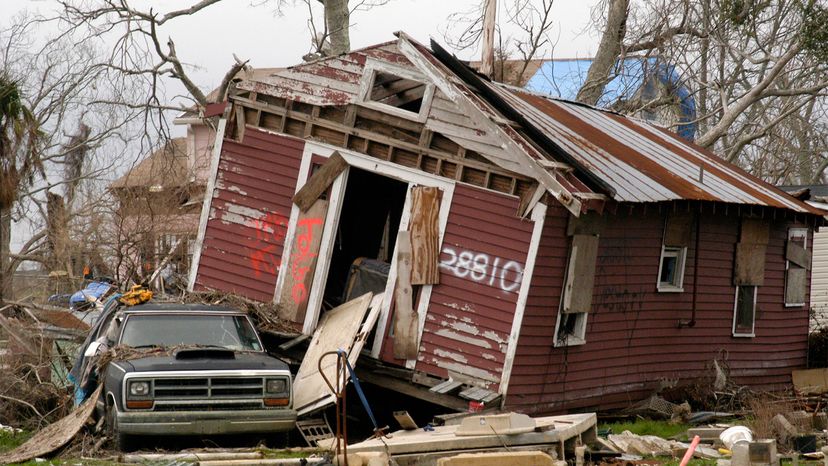 “Thousands of homes were destroyed in Plaquemines Parish, Louisiana, by Hurricane Katrina and the sad fact is that most homeowners were woefully underinsured to cover the catastrophic damage they suffered. Alice Welch/USDA/Flickr
“Thousands of homes were destroyed in Plaquemines Parish, Louisiana, by Hurricane Katrina and the sad fact is that most homeowners were woefully underinsured to cover the catastrophic damage they suffered. Alice Welch/USDA/Flickr
One thing to keep in mind about homeowners insurance is that if you’re like most people, you probably don’t have enough coverage.
"Whenever we do a survey in a disaster area, we generally find that two-thirds of the people whose homes are a total loss are severely underinsured," explains Amy Bach, an attorney and executive director of United Policyholders, a California-based nonprofit consumer advocacy group, in a telephone interview.
How much homeowners insurance you need to buy depends on a variety of factors. That includes what sort of natural disasters are most likely to occur in your region, the size and age of your home, how much local construction costs may run, and how many and what sort of possessions you own and what their value may be. But the most crucial consideration, experts say, is not how much your home and valuables cost when you purchased them, but how much it will cost to replace them. You want to make sure that the policy that you buy provides that much coverage — even if that means supplementing the standard policy with additional coverage to cover the particular risks that you face.
Make Sure You’re Covered for the Right Risks
Your first consideration should be whether you’re covered for the sort of bad things that might happen to your home. Standard homeowners policies provide coverage if your home is damaged or destroyed by fire, lightning strikes, explosions and other hazards, according to the Insurance Information Institute, an industry group that provides information to consumers.
But those policies don’t cover certain types of risks, such as flooding or earthquakes. So if you live in a coastal area that’s vulnerable to rising water whenever there’s a big storm, you’re going to want to buy special flood protection provided by the National Flood Insurance Program (NFIP). Similarly, if you’re in a part of the country such as California, where there are earthquake faults all over the place, you would be wise to obtain that sort of coverage as well, according to the institute.
How to Figure the Cost of Replacing Your Home
The next step in calculating how much coverage you need is to figure out how much it would cost to rebuild your home if it’s totally destroyed by some disaster.
"Many homeowners think of market value when they purchase insurance, but what you should consider are reconstruction costs," Robert Buckel, a vice president and product manager for Erie Insurance, explains via email.
Bach says that replacement cost is an especially crucial consideration if you live in a part of the country where wildfires sometimes happen, or where there are hurricanes and flooding — the sort of natural disasters that often turn a house into a total loss, rather than just damaging it. For example, if you live in California, where giant blazes seem to threaten neighborhoods with frightening frequency these days, "it’s important to insure your home to full value," she cautions.
Calculating that replacement cost can be tricky, according to the Insurance Information Institute, because what you paid for your home — or how much it is worth on the market now — doesn’t necessarily reflect what it would cost to rebuild it from scratch.
One rough formula for calculating that cost is to take the total square footage of your home and multiply it by what local construction contractors charge on a per-square-foot basis. You can get that last piece of information from a local real estate agent or builders’ association, or else from your insurance agent, according to the Insurance Information Institute.
But to get a more precise idea, the Insurance Information Institute says you may need to factor in other variables as well, such as whether your house is wood frame or masonry, whether it followed a standard plan or was custom construction, and whether you’ve added improvements, such as an additional bathroom or a fancy kitchen renovation. And if you’ve got an older home, it may have some features, such as vintage wall and ceiling moldings and carvings that would cost a lot of money to re-create.
"Insurance companies may give an estimate, but prices could differ in your particular area or after a catastrophe due to demand surge," Janet Ruiz, the Insurance Information Institute’s director for strategic communication, adds in an email. "Check with a local builder to find out what the going rate is per square foot for a similar quality home. Include any specialty types of materials you may have in your home."
"Finally, think about the unique attributes of your home — for example, you may want extra liability insurance for a pool in the backyard, or water back up coverage if you have a basement," Angi Orbann, vice president of property for personal insurance at Travelers Insurance, says via email.
Don’t Forget About All Your Stuff
Standard homeowners policies generally provide coverage for your belongings that’s equivalent to 50 to 70 percent of the coverage for your home, according to the Insurance Information Institute. But that may not necessarily be enough to cover what you own, especially if you’re the sort who lives large and owns a lot of flashy, pricey stuff. That’s why the Insurance Information Institute recommends that you do a detailed inventory of your possessions before you take out a policy, to make sure you’re adequately covered.
To complicate things even more, standard policies usually provide only limited coverage for luxury items such as jewelry, silverware, collectables and furs, or for computers. (The good news is that you can fix that by buying additional coverage on those items, either individually or as part of a collection.)
Another option you’ll want to consider is whether you want to insure your possessions for the current cash value, or for the replacement cost. Replacement cost generally runs about 10 percent more, but it could be money well spent, if you own a lot of older items.
Where Will You Stay While Your Home is Rebuilt?
While you’ve got a construction crew rebuilding your home, you’re probably going to have to stay somewhere else, and that can end up being pretty expensive. That’s why the additional living expenses (ALE) feature of your policy is pretty important. In addition to the cost of renting accommodations in a hotel, ALE also generally covers meals in restaurants and other living expenses.
Typically, ALE coverage is about 20 percent of the insurance on your house, but that can vary from company to company, according to the Insurance Information Institute.
In addition to covering your losses due to disasters, homeowners insurance also includes liability coverage that protects you in the event that you, family members or your pet animal injures someone or causes property damage to them and you get hit with a lawsuit as a result. You want to have enough liability coverage to protect your assets. Most policies provide at least $100,000 in coverage, but the Insurance Information Institute recommends that you consider buying three to five times that.
Now That’s Interesting
When you calculate the replacement cost for your home, you should include other structures on your property, such a garages and sheds, according to the Insurance Information Institute.
































